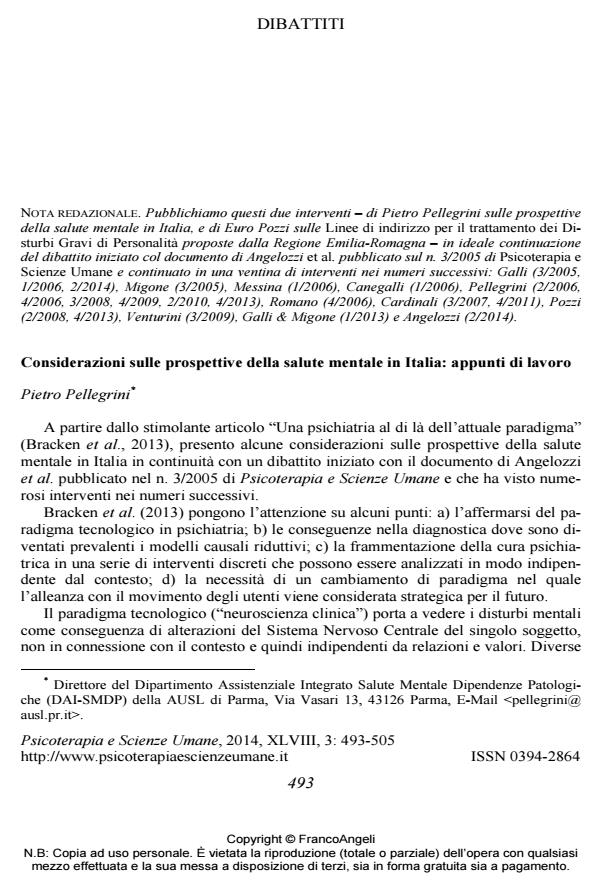On the perspectives of mental health in Italy: Working notes
Journal title PSICOTERAPIA E SCIENZE UMANE
Author/s Pietro Pellegrini
Publishing Year 2014 Issue 2014/3 Language Italian
Pages 0 P. 493-505 File size 73 KB
DOI 10.3280/PU2014-003008
DOI is like a bar code for intellectual property: to have more infomation
click here
Below, you can see the article first page
If you want to buy this article in PDF format, you can do it, following the instructions to buy download credits

FrancoAngeli is member of Publishers International Linking Association, Inc (PILA), a not-for-profit association which run the CrossRef service enabling links to and from online scholarly content.
The perspectives of Mental Health Services make us reflect on the theoretical basis, the mental health professionals’ responsibilities, the mandates of care and control. In Italy there is also the problem of the organization of the Departments of Community Psychiatry, that are not the same in different Regions. Furthermore there is a unity of neurology and psychiatry (neuropsychiatry) for childhood and adolescence, while in adult psychiatry the two disciplines are separated since many years. The need to modernize the organization also to make it more appropriate to address the wide gap between demand and supply, and new needs in a renewed relationship with users and their movements, are emphasized.
Keywords: Mental health, skills, paradigms of psychiatry, services-user movement in psychiatry
- Angell M. (2011). The epidemic of mental illness: Why? The New York Review of Books, 58, 11 (23 giugno): 20-22; The illusions of psychiatry. The New York Review of Books, 58, 12 (14 luglio): 20-22 (trad. it. di entrambi gli articoli: L’epidemia di malattie mentali e le illusioni della psichiatria. Psicoterapia e Scienze Umane 2012, XLVI, 2: 263-282. DOI: 10.3280/PU2012-002008)
- Angelozzi A., Bassi M., Cappellari L., Favaretto G., Ferrannini L., Fioritti A., Munizza C., Peloso P., Perozziello F., Pirfo E., Rossi I., Scapati F. & Zuccolin M. (2005). Documento sullo stato e sulle prospettive della psichiatria italiana. Psicoterapia e Scienze Umane, XXXIX, 3: 293-306.
- Bracken P., Thomas P., Timimi S., Asen E., Behr G., Beuster C., Bhunnoo S., Browne I., Chhina N., Double D., Downer S., Evans C., Fernando S., Garland M.R., Hopkins W., Huws R., Johnson B., Martindale B., Middleton H., Moldavsky D., Moncrieff J., Mullins S., Nelki J., Pizzo M., Rodger J., Smyth M., Summerfield D., Wallace J. & Yeomans D. (2012). Psychiatry beyond the current paradigm. British Journal of Psychiatry, 201, 6: 430-434. DOI: 10.1192/bjp.bp.112.109447(trad.it.:Unapsichiatriaaldilàdell’attualeparadigma.PsicoterapiaeScienzeUmane,2013,XLVII,1:9-22.DOI:10.3280/PU2013-001002)
- Gallese V., Migone P. & Eagle M.N. (2006). La simulazione incarnata: i neuroni specchio, le basi neurofisiologiche dell’intersoggettività e alcune implicazioni per la psicoanalisi. Psicoterapia e Scienze Umane, XL, 3: 543-580.
- Migone P. (2013). Presentazione del DSM-5. Psicoterapia Scienze Umane, XLVII, 4: 567-600. DOI: 10.3280/PU2013-004001
- Ministero del Lavoro, della Salute e delle Politiche Sociali, Dipartimento della Qualità, Ufficio III (2009). Protocollo per il Monitoraggio degli Eventi Sentinella. Internet: http://www.salute.gov.it/imgs/c_17_pubblicazioni_1783_allegato.pdf.
- Ministero della Salute, Dipartimento della Qualità, Ufficio III (2008). Prevenzione del suicidio di paziente in ospedale. Raccomandazione n. 4, Marzo 2008. Internet: http:// www.salute.gov.it/imgs/C_17_pubblicazioni_592_allegato.pdf.
- NZGG (New Zealand Guidelines Group) (2003). The Assessment and Management of People at Risk of Suicide. Wellington (NZ): Ministry of Health. Internet: http:// www.health.govt.nz/publication/assessment-and-management-people-risk-suicide.
- Pellegrini P. (2013). Alcune riflessioni sulle “Raccomandazioni per la prevenzione delle condotte suicidarie nel territorio”. Psicoterapia e Scienze Umane, XLVII, 4: 658-662. DOI: 10.3280/PU2013-004005
- Percudani M. et al., a cura di (2013). La psichiatria di comunità in Lombardia. Il Piano Regionale per la salute mentale lombardo e le sue linee d’indirizzo (2004-2012). Milano: McGraw Hill.
- Pozzi E. (2013). Alcune riflessioni sulle “Raccomandazioni per la prevenzione delle condotte suicidarie”. Psicoterapia e Scienze Umane, XLVII, 4: 663-672. DOI: 10.3280/PU2013-004005
- Regione Emilia-Romagna, Servizio Salute Mentale, Dipendenze Patologiche Salute, nelle Carceri, a cura di (2012a). Raccomandazioni per la prevenzione delle condotte suicidarie in ospedale. Bologna: Regione Emilia-Romagna. Internet: http://www.saluter.it/documentazione/leggi/regionali/lineeguida/raccomandazioni_prevenzion_suicidi_ospedale.pdf/view?searchterm=suicidio.
- Regione Emilia-Romagna, Servizio Salute Mentale, Dipendenze Patologiche, Salute nelle Carceri, a cura di (2012b). Raccomandazioni per la prevenzione delle condotte suicidarie nel territorio (a cura di C. Ravani, M. Ferri, G. Garaffoni, M. Martinelli, F. Marzullo, A. Mosca, G. Nappi, A. Saponaro, S. Sforza, S. Ventura, E. Verdini & M. Vescovi). Bologna: Regione Emilia-Romagna. Internet: www.saluter.it/documentazione/leggi/regionali/lineeguida/raccomandazioni_prevenzione_suicidi_territorio.pdf.
- Seung S. (2012). Connectome: How the Brain’s Wiring Makes Us Who We Are. Boston: Houghton Mifflin (trad. it.: Connettoma. La nuova geografia della mente. Torino: Codice, 2013).
- Spitzer R.L. & Frances A. (2011). Guerre psicologiche: critiche alla preparazione del DSM-5. Psicoterapia e Scienze Umane, XLV, 2: 247-262. DOI: 10.3280/PU2011-002007
Pietro Pellegrini, Considerazioni sulle prospettive della salute mentale in Italia: appunti di lavoro in "PSICOTERAPIA E SCIENZE UMANE" 3/2014, pp 493-505, DOI: 10.3280/PU2014-003008